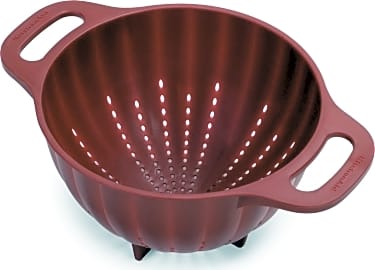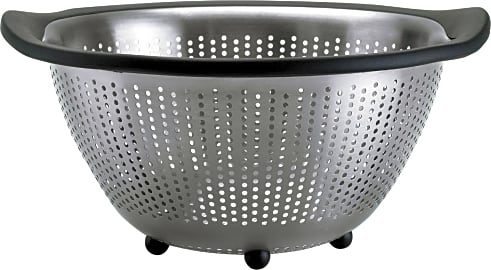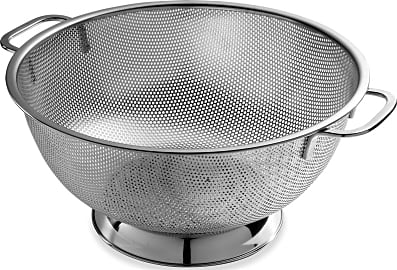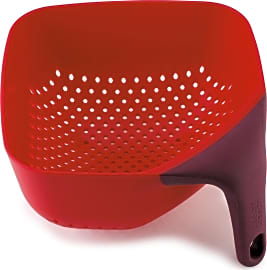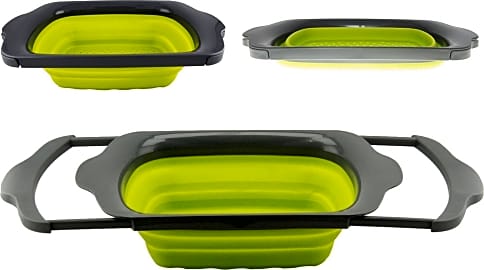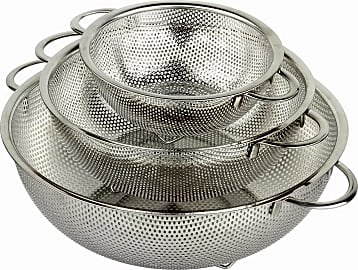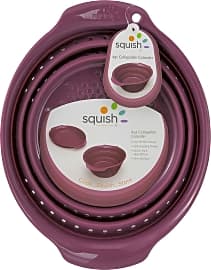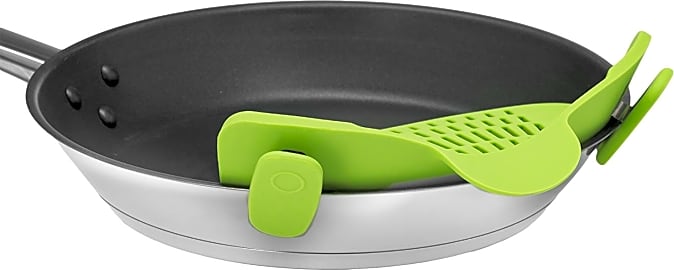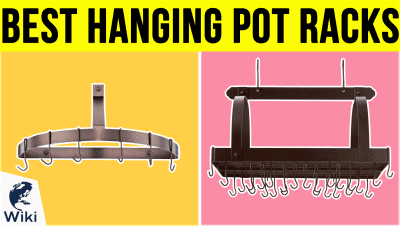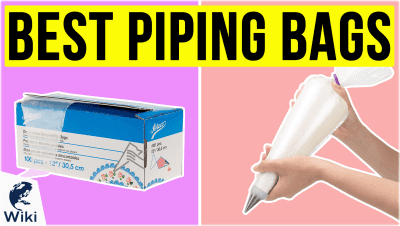The 10 Best Colanders

This wiki has been updated 36 times since it was first published in February of 2016. Every cook needs a colander, and they have come a long way since they were first introduced. Drain everything from pasta and rice to fruits and vegetables in one of these handy food strainers. Today's models are available in a wide variety of styles, colors, materials, and sizes to suit any kitchen and cuisine, and some even collapse or nest to save on storage space. When users buy our independently chosen editorial picks, we may earn commissions to help fund the Wiki.
Editor's Notes
July 23, 2019:
While the Good Cooking Extra-Large and TedGem Collapsible are solid models that work relatively well, we felt that an upgrade was needed due to complaints of the silicone splitting, among other things. We decided to add the Squish Plum Collapsible and Kitchen Gizmo Snap 'N Strain, the latter which we feel is exceptionally convenient for dorm rooms, cramped apartments, RV's, and camping. It will most likely fit your pots and pans but bear in mind that no design can be 100% universal.
We loved the idea of the Papaya Bay Professional, but because of reports of rust and thin material, we supplanted it with the Holm 3-Piece, a good value for money with a thoughtful design. Just be careful with tiny grains like quinoa, which might be barely too small for the 2.3-mm holes.
The Norpro Krona remains a solid, well-made option, but we felt we could do a bit better for this update and swapped it for the Raishi Easy, a similar choice with an upgraded base that is dishwasher safe (unlike the Norpro) and just a bit easier on the wallet.
Many of our choices sport small, thoughtful features like strategically-placed pour spouts (IE Squish Plum Collapsible), added layers of rubber that create soft, grippy surfaces (the Joseph Joseph 40060 and Oxo Good Grips 5-Quart) and overlarge handles that are suitable for hanging pot racks, (KitchenAid Classic, Bellemain Micro-perforated, Holm 3-Piece Set).
Many of our selections are FDA-approved, capable of withstanding extreme temperatures, dishwasher safe, and durable. Outside of those main priorities, we sought items that were practical, clever, and versatile.
Special Honors
Sheldon Ceramics Vermont A functional kitchen staple made to last a lifetime, the Vermont Large Colander is hand thrown by ceramist Peter Sheldon in his Los Angeles, California studio. The interior is treated with a classic white glaze that is food safe, while the sturdy granite clay body sports a rustic look ideal for farmhouse kitchens. sheldonceramics.com
Vollrath 68350 Aluminum The Vollrath 68350 Aluminum is a 16-quart, commercial-grade colander ideal for heavy-duty kitchens. Crafted from impact-resistant 3004 aluminum, it's outfitted with a sturdy, full-ring welded base, thickened walls and rim, and strong riveted handles for easy transport. It's perfect for washing large amounts of vegetables and straining cooked pasta and potatoes, and it's designed to last for many years. chefstoys.com
MacKenzie-Childs Large Green Enamel Flower Market A great hostess or housewarming gift, the Large Green Enamel Flower Market brings personality to the typically mundane colander design. It boasts a heavy-gauge, hand-glazed steel underbody with hand-applied floral transfers, is rimmed with bronze stainless steel, and sports antiqued brass handles. While it is dishwasher safe, handwashing is the best way to extend this piece's lifetime. It exceeds the strictest safety standards in the USA. mackenziechilds.com
Why You Need A Colander
Colanders allow you to thoroughly strain the water from your food, too.
You can try to get by in your cooking endeavors without a colander, but you'll quickly regret it. When you attempt to strain liquid from your food without this device, you start turning to some odd tactics, like pressing the lid over the pot, sliding it back just enough to let out water, and turning it upside down over the sink. However, this poses several issues. For starters, you shouldn't press your thumbs hard onto the piping hot metal or steel lid that has been containing boiling water for the last several minutes — that's a recipe for a burn. When using a colander, you can simply hold the handle of the pot, remove the lid entirely, and dump its contents safely into the useful item.
If the heat doesn't scare you, then the prospect of losing some of your carefully-made meal might. When you try the aforementioned lid-compressing technique, you risk having some of your food fall out of the pot entirely and down the drain. This is especially true with spaghetti, angel hair, and other skinny pastas that can easily fall out of that little crack you create between the lid and the pot to release water. A colander has holes tiny enough to drain just the water, and nothing else. You won't have to sadly watch your perfectly-cooked fettuccine slide down the sink when you use one.
Colanders allow you to thoroughly strain the water from your food, too. You just can't get every last drop of water out when you try alternative methods. If you love your pasta al dente then there's some good news: it's actually better for you than the fully cooked stuff since it takes longer to digest, making it lower on the glycemic index. That being said, when you can't completely remove the hot water from your mound of spaghetti, the stuff may continue to cook slightly, becoming mushier than you wanted. If you want that ideal level of firmness in your angel hair, then you need to get all the water out the second it's ready. Should you want to run a little cold water over your food just to cool it off, you'll need to a colander to do that, too.
Unique Uses For A Colander
Colanders can do more than drain your pasta. Once you own one, you'll find tons of uses for the item. They come in handy when you want to rinse several pieces of fruits or vegetables at once. It's much easier and quicker to put a bunch of apples in a colander and run them under the sink than it is to wash a dozen of them individually.
The perforations will give the produce the air it needs, but they're small enough to keep most bugs out.
You can also use a colander to store more fragile produce that's prone to mold. While there's a lot to know about mold, it's safest to just keep it away from anything you plan on consuming. Luckily, a colander can help you do that. Consider keeping berries, mushrooms, and other foods that can turn bad when exposed to moisture inside of one when in the fridge. The holes in the bowl allow your produce to breathe, helping to keep it fresher. You can use your colander to protect produce that lives on the counter, too. Just take two colanders, put your bananas, oranges, and the like inside of one and place the second one on top. The perforations will give the produce the air it needs, but they're small enough to keep most bugs out.
The various forms of cooking from frying to boiling affect the nutrients of your food in different ways, but steaming typically helps vegetables retain most of their vitamins and minerals. You can use a metal colander to prepare your food that way when you don't have a steamer basket. When cooking with grease, you can use your metal colander to protect yourself against splatter. Simply place a colander upside down over the eggs or bacon you're frying. It will contain the spray while still letting the hot food ventilate.
A Colander Vs. A Sieve
Many people mistake colanders for sieves and visa versa. While these are both members of the strainer family, they are two entirely different devices serving their own respective purposes. In a simple, broad sense, colanders are used to remove liquid from food, while sieves are used to collect it — or in some cases to sift foods. If you're a baker who often needs to remove clumps from your flour or cocoa powder and you don't have a flour sifter, a sieve can be used as a substitute.
This design allows you to rest the sieve over a pot while you dump something like hot water that's been boiling chicken into the lower chamber.
There are a few features that make colanders and sieves distinctly different and best suited for their jobs. Colanders tend to have two handles of the same size and shape on either side allowing you to hold them steadily after dumping mounds of steamed broccoli or cooked rotini into them. Sieves will have one long handle and a hook or loop on the opposite side. This design allows you to rest the sieve over a pot while you dump something like hot water that's been boiling chicken into the lower chamber. You then get to collect just the savory broth and keep the meat out.
Colanders will always have a rounded bowl while sieves can have either a round or cone-shaped bowl. Colanders also have feet enabling them to stand in a sink while you pour food into them. Sieves won't have these since they're always intended to sit over a pot or be held over a bowl. Two other important differentiating features are the materials and the nature of the holes. Colanders might be made of aluminum, steel, or plastic, and feature round holes scattered throughout the bowl — sometimes in large clusters towards the bottom. Sieves contain a mesh wire that forms ultra fine, uniform holes all over the bowl. As you can see, the two products are not one in the same, but both are important for any chef.


